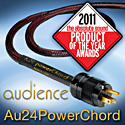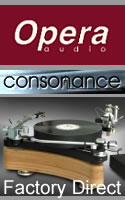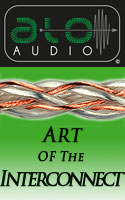|
|
You are reading the older HTML site
Positive Feedback ISSUE 59
lexicon MC-8 Preamplifier/Controller as reviewed by Dan Dzuban
More goodies from Unintended Use-ville… Occasionally you can get some great performance out of products that were built and marketed for certain market segments and uses other than what you intend to use them for. For example, AppleTV is meant for video, but it makes a killer, inexpensive audio server for us audiophile types. I ran across another such bargain worth discussing. In 2003, Lexicon (now part of the Harman group, but then part of Madrigal Labs, and sister company to Mark Levinson), released the follow up to their landmark MC-1 home theater controller. The $6,000 MC-1 was considered state of the art for home theater sound, and first tier for two-channel audio. The MC-8 was to improve upon it in nearly every way. And then an MC-12 product was released for people who needed more multi-room capabilities and needed even more configuration flexibility. However, as many companies have found, producing home theater processors and receivers is more akin to releasing computer products than audio products; a component may be obsolete only a few short months after its release due to new decoding algorithms, new connections, new DACs, and new processing power. The MC-8 fell victim to this phenomenon. It was originally an $8000 processor ($9000 in balanced version), but was soon dropped to $6000. A few years later, a "v.2" version was released, which included new Dolby Pro Logic 7.1 processing. All indications were that it was a stellar product, and worthy successor to the MC-1. However, along came DVI digital video connections. Then HDMI soon thereafter. And sophisticated room-correction DSP. And the latest greatest versions of Dolby Pro Logic processing. And new DACs. For well-heeled videophiles who were willing to pay $6000 for state of the art home theater audio processing, the MC-8 was no longer state of the art. In other words, for its intended market, it was obsolete. Wow.
For some context, that was about the time I was involved with a home theater custom installation company. We sold Krell, which essentially went head to head with Mark Levinson products for stereo and with Lexicon for home theater. It was hard to fault Levinson for stereo, but with Lexicon, the word on the street was that the Lexicon processors digitized all their inputs—which was great for folks who believed the more processing the better, but less good for audiophiles who liked their music as unprocessed as possible. I came to find that this was only partially true. Lexicon digitized everything… by default. But if you took the time to wade through some pretty sophisticated menus, you could switch off all processing and instead have your analog signals in unmolested "bypass mode." Bypass mode meant that for all intent and purposes, your signals were now being switched and amplified by a near cost-no-object solid state preamp and all which that entails. Bringing things back to the present, now Lexicon only sells the MC-12HD, and only in balanced configuration. It initially listed at $14,000, but now retails for $11,000. This HD version is, once again, intended to be the cutting edge for home theater processors, employing the latest audio processing algorithms, versions of Dolby Pro Logic, etc. But I confirmed with Lexicon that its analog audio circuitry remains the same as of the MC-8. Of all people, I don't want to make the mistake of assuming that because a product has a high price tag, it automatically has the performance to warrant it. But in terms of analog stereo, it does from what I can tell. What I now have is a 17 pound solid-state preamp with a 2/3 inch faceplate, a volume control that glides along, impeccable build quality, and exceptional sound quality—all exactly on par for what you would expect for a $6k piece of equipment. We are talking major pride of ownership. But since it is of virtually no use for its intended market, it can be found used, for a song. It would have been silly 8 years ago to spend the money to buy this component and then switch off all of the digital processing so that it could be used as a stereo preamp, but it is just as silly today to pass up this kind of sound just because it is (was) primarily a home theater processor. One market segment's loss is your gain. Unintended Uses The MC-8 is an exceptional analog preamp. Its superiority to my Parasound became clear nearly immediately; within just a few minutes of warm up, I could hear that this is no preamp to be trifled with. My system got an immediate bump up in clarity, along with more space between sounds, as well as a sense of "blacker" space between sounds. Good deal. But what that did was allow more phase information to come through in each recording. As sound emanated from instruments, I could better hear the individual radiation pattern of each sound, and how those individual patterns radiated throughout the soundstage. "Baby, Now that I Found You," from Alison Krauss' Now That I Found You: Collection (Rounder: 1995) is an excellent recording to show off this phenomenon. The recording contains lots of plucked, struck, strummed, and bowed instruments along with Krauss' voice and the voices of her background singers. There were lots of different sounds with lots of different textures, lots of different "bloom" and lots of different decay. I keep saying that I hate country music, but this song (and album) is simply a joy to listen to for anyone who really loves music. And the Lexicon made it sound even better. But perhaps the most startling difference was that individual images had much more body and dimension. While reviewing Emotiva's amazing budget reference UPA-2 amp, I had originally noted a flat sounding quality to its imaging. Not soundstaging, imaging—the soundstage was plenty deep and broad, but the individual images seemed two-dimensional. Still amazing performance for a $400 amp, I thought. But the Lexicon revealed that it was actually the Parasound preamp behind the flat imaging. The Parasound is still a clear bargain, but it is literally one tenth of the cost of the Lexicon's original price, and you do, in this case, get at least a bit more for your money. Anita Kelsey's "The Night Has a Thousand Eyes" from the Dark City soundtrack (B000005ZD5: 1998) is a perfect match for the movie itself; if Dark City was sci-fi film noire, this song is audio noire. Kelsey's sultry voice sounded intimate, while juxtaposed with the smoky space of the recording venue (a lounge?). Her voice came through stark and clear, but she sounded more human, rather than merely coming from a point in space. This recording also showed that the Lexicon expanded the soundstage forward a bit, in contrast with the Parasound, which put the soundstage behind the plane of the speakers. Intended Uses I honestly don't need the latest audio processing—and I certainly have zero interest in connecting my video sources to the controller so that I can switch them. My single Bluray to projector HDMI connection works perfectly fine without needing re-routing through my controller. But as a bonus to all that stereo goodness, I can still use the MC-8 for its intended home theater processing capabilities. As for audio, it absolutely trounced my respected Onkyo 7.1 receiver's home theater processing—regardless of what version Dolby processing my Onkyo has. Perhaps somewhat ironically, Lexicon's proprietary Logic 7 processing algorithm is so good, that I really don't see the need to keep up with the audio processing arms race nor chase the latest Dolby version. For example, the sound field through the Lexicon was much more uniform and seamless, rather than sounds making discrete jumps from speaker to speaker as they panned by, via the Onkyo. To think that I had always blamed that on my speakers…tisk, tisk. The system also got a major jolt in dynamics and clarity—which I had also previously attributed to my speakers. Until the Lexicon was dropped in place, I had never realized just how lacking my system was. I just don't care as much about sound quality in home theater, but with its insertion, the sound quality took a dramatic leap up, and I was very pleasantly surprised. I guess there is something to be said for cutting-edge home theater processing—even if only cutting edge by eight-year-old standards. I have no real use for the MC-8's multi-room configurability, other than perhaps using it to drive an outboard headphone amp (since it has no headphone output of its own). I actually got distinctively better sound out of my Headroom BitHead headphone amplifier by running the sound from my DAC to the Lexicon, then to the BitHead, rather than from the DAC directly to the BitHead. I don't know why, but I ain't complainin'. But with all of the MC-8's supposed configurability, I wish that I could reconfigure its multi-room outputs to use them as additional RCA stereo outputs. I think dual stereo outputs should be standard equipment on any modern preamp—giving you the flexibility to bi-amp or run stereo sub bass. But with the MC-8's home theater focus, it shouldn't have been a surprise that the MC-8 only had a single pair of RCA stereo outputs to go with the rest of the 7.1 outputs. I think its mono subwoofer RCA output is still active during bypass mode, but I just don't want my sub bass summed. So with a $6k preamp, I still find myself using my angled RCA 1 male x 2 female splitter so that I can have separate runs of left and right interconnect going to my amp and subwoofer. The MC-8's user interface is pretty sophisticated, and it takes a few hours of effort to familiarize yourself with. Eventually you will learn how to turn off all video features, and set the analog inputs to bypass. The front panel display's bright blue lettering scheme was a bit distracting during movies and listening sessions, so I tried turning it off. I ended up dimming it to 50% brightness, because being able to see a volume number and linear graph for late night listening sessions when the rest of the family is sleeping is invaluable. I not only have always seen remote volume control as a necessity, but I need a visual indicator of volume as well. With all the different variations in volume of music these days, I am constantly turning the music up and down so as to enjoy the music without waking the family. Note that I didn't hear any sonic differences with the display on or off though. Unintended Sources of Unintended Uses There are lots of situations where the unintended use of equipment can bring quite a bit of bang for the buck, but I didn't foresee first-tier sound being the unintended use of commercially obsolete equipment. The Lexicon MC-8 was a cutting-edge product in its day, but unlike home theater processing, analog stereo preamplifier technology doesn't change nearly so fast. What was cutting-edge there eight years ago is likely still pretty close to the cutting edge today. And that doesn't just apply to Lexicon. I suspect that there are numerous models and brands of first-tier home theater processors that are obsolete as commercial products, but yet are still competitive with first-tier stereo preamplifiers. I guess the moral of the story here is if you really know what your sonic priorities are, you too may get a taste of the analog performance you would get from a top-tier $14,000 preamp/controller. Dan Dzuban
Lexicon MC-8
Lexicon
|









